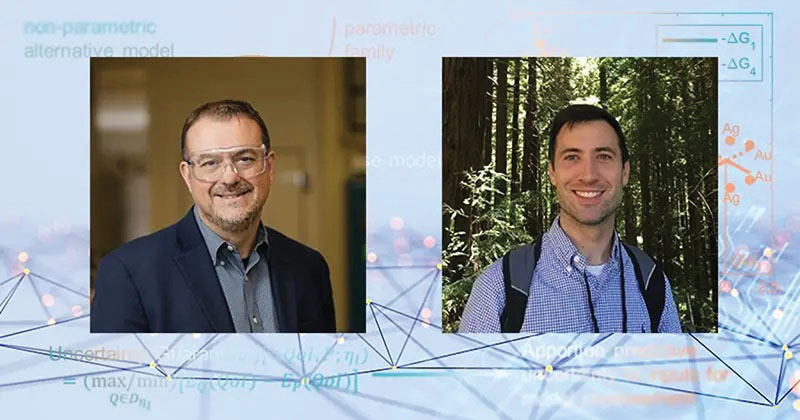Prof. Dion Vlachos (left), director of UD’s Catalysis Center for Energy Innovation, and Joshua Lansford, a doctoral student in UD’s Department of Chemical and Biomolecular Engineering, are co-authors on the paper recently published in the journal Science Advances.
UD’s Vlachos and Lansford develop high-confidence approach for artificial intelligence-based models
They call it artificial intelligence — not because the intelligence is somehow fake. It’s real intelligence, but it’s still made by humans. That means AI — a power tool that can add speed, efficiency, insight and accuracy to a researcher’s work — has many limitations.
It’s only as good as the methods and data it has been given. On its own, it doesn’t know if information is missing, how much weight to give differing kinds of information or whether the data it draws on is incorrect or corrupted. It can’t deal precisely with uncertainty or random events — unless it learns how. Relying exclusively on data, as machine-learning models usually do, it does not leverage the knowledge experts have accumulated over years and physical models underpinning physical and chemical phenomena. It has been hard to teach the computer to organize and integrate information from widely different sources.
Now researchers at the University of Delaware and the University of Massachusetts-Amherst have published details of a new approach to artificial intelligence that builds uncertainty, error, physical laws, expert knowledge and missing data into its calculations and leads ultimately to much more trustworthy models. The new method provides guarantees typically lacking from AI models, showing how valuable — or not — the model can be for achieving the desired result.
Joshua Lansford, a doctoral student in UD’s Department of Chemical and Biomolecular Engineering, and Prof. Dion Vlachos, director of UD’s Catalysis Center for Energy Innovation, are co-authors on the paper published Oct. 14 in the journal Science Advances. Also contributing were Jinchao Feng and Markos Katsoulakis of the Department of Mathematics and Statistics at the University of Massachusetts-Amherst.
The new mathematical framework could produce greater efficiency, precision and innovation for computer models used in many fields of research. Such models provide powerful ways to analyze data, study materials and complex interactions and tweak variables in virtual ways instead of in the lab.
“Traditionally in physical modelings, we build a model first using only our physical intuition and expert knowledge about the system,” Lansford said. “Then after that, we measure uncertainty in predictions due to error in underlying variables, often relying on brute-force methods, where we sample, then run the model and see what happens.”
Effective, accurate models save time and resources and point researchers to more efficient methods, new materials, greater precision and innovative approaches they might not otherwise consider.
The paper describes how the new mathematical framework works in a chemical reaction known as the oxygen reduction reaction, but it is applicable to many kinds of modeling, Lansford said.
“The chemistries and materials we need to make things faster or even make them possible — like fuel cells — are highly complex,” he said. “We need precision…. And if you want to make a more active catalyst, you need to have bounds on your prediction error. By intelligently deciding where to put your efforts, you can tighten the area to explore.
“Uncertainty is accounted for in the design of our model,” Lansford said. “Now it is no longer a deterministic model. It is a probabilistic one.”
With these new mathematical developments in place, the model itself identifies what data are needed to reduce model error, he said. Then a higher level of theory can be used to produce more accurate data or more data can be generated, leading to even smaller error boundaries on the predictions and shrinking the area to explore.
“Those calculations are time-consuming to generate, so we’re often dealing with small datasets — 10-15 data points. That’s where the need comes in to apportion error.”
That’s still not a money-back guarantee that using a specific substance or approach will deliver precisely the product desired. But it is much closer to a guarantee than you could get before.
This new method of model design could greatly enhance work in renewable energy, battery technology, climate change mitigation, drug discovery, astronomy, economics, physics, chemistry and biology, to name just a few examples.
Artificial intelligence doesn’t mean human expertise is no longer needed. Quite the opposite.
The expert knowledge that emerges from the laboratory and the rigors of scientific inquiry is essential, foundational material for any computational model.
About the researchers
In addition to serving as CCEI director, Vlachos is the Allan and Myra Ferguson Professor of Chemical and Biomolecular Engineering, professor of physics and astronomy, director of the Delaware Energy Institute and leader of Intensified Process Fundamentals for the RAPID Manufacturing Institute.
Lansford, a graduate of the University of Virginia and now a doctoral student at UD, is a 2019-20 Blue Waters Fellow, focused on developing predictive models in catalysis.

